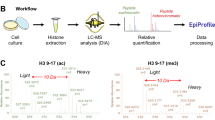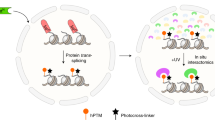Abstract
Specific interactions between post-translational modifications (PTMs) and chromatin-binding proteins are central to the idea of a 'histone code'. Here, we used a 5,000-member, PTM-randomized, combinatorial peptide library based on the N terminus of histone H3 to interrogate the multisite specificity of six chromatin binding modules, which read the methylation status of Lys4. We found that Thr3 phosphorylation, Arg2 methylation and Thr6 phosphorylation are critical additional PTMs that modulate the ability to recognize and bind histone H3. Notably, phosphorylation of Thr6 yielded the most varied effect on protein binding, suggesting an important regulatory mechanism for readers of the H3 tail. Mass spectrometry and antibody-based evidence indicate that this previously uncharacterized modification exists on native H3, and NMR analysis of ING2 revealed the structural basis for discrimination. These investigations reveal a continuum of binding affinities in which multisite PTM recognition involves both switch- and rheostat-like properties, yielding graded effects that depend on the inherent 'reader' specificity.
This is a preview of subscription content, access via your institution
Access options
Subscribe to this journal
Receive 12 print issues and online access
$259.00 per year
only $21.58 per issue
Buy this article
- Purchase on Springer Link
- Instant access to full article PDF
Prices may be subject to local taxes which are calculated during checkout





Similar content being viewed by others
References
Luger, K., Mader, A.W., Richmond, R.K., Sargent, D.F. & Richmond, T.J. Crystal structure of the nucleosome core particle at 2.8 A resolution. Nature 389, 251–260 (1997).
Taverna, S.D., Li, H., Ruthenburg, A.J., Allis, C.D. & Patel, D.J. How chromatin-binding modules interpret histone modifications: lessons from professional pocket pickers. Nat. Struct. Mol. Biol. 14, 1025–1040 (2007).
Kouzarides, T. Chromatin modifications and their function. Cell 128, 693–705 (2007).
Strahl, B.D. & Allis, C.D. The language of covalent histone modifications. Nature 403, 41–45 (2000).
Bienz, M. The PHD finger, a nuclear protein-interaction domain. Trends Biochem. Sci. 31, 35–40 (2006).
Baker, L.A., Allis, C.D. & Wang, G.G. PHD fingers in human diseases: disorders arising from misinterpreting epigenetic marks. Mutat. Res. 647, 3–12 (2008).
Matthews, A.G. et al. RAG2 PHD finger couples histone H3 lysine 4 trimethylation with V(D)J recombination. Nature 450, 1106–1110 (2007).
Org, T. et al. The autoimmune regulator PHD finger binds to non-methylated histone H3K4 to activate gene expression. EMBO Rep. 9, 370–376 (2008).
Lan, F. et al. Recognition of unmethylated histone H3 lysine 4 links BHC80 to LSD1-mediated gene repression. Nature 448, 718–722 (2007).
Guenther, M.G., Levine, S.S., Boyer, L.A., Jaenisch, R. & Young, R.A. A chromatin landmark and transcription initiation at most promoters in human cells. Cell 130, 77–88 (2007).
Wysocka, J. et al. A PHD finger of NURF couples histone H3 lysine 4 trimethylation with chromatin remodelling. Nature 442, 86–90 (2006).
Vermeulen, M. et al. Selective anchoring of TFIID to nucleosomes by trimethylation of histone H3 lysine 4. Cell 131, 58–69 (2007).
Shi, X. et al. ING2 PHD domain links histone H3 lysine 4 methylation to active gene repression. Nature 442, 96–99 (2006).
Iberg, A.N. et al. Arginine methylation of the histone H3 tail impedes effector binding. J. Biol. Chem. 283, 3006–3010 (2008).
Ramon-Maiques, S. et al. The plant homeodomain finger of RAG2 recognizes histone H3 methylated at both lysine-4 and arginine-2. Proc. Natl. Acad. Sci. USA 104, 18993–18998 (2007).
Fischle, W. et al. Regulation of HP1-chromatin binding by histone H3 methylation and phosphorylation. Nature 438, 1116–1122 (2005).
Flanagan, J.F. et al. Double chromodomains cooperate to recognize the methylated histone H3 tail. Nature 438, 1181–1185 (2005).
Couture, J.F., Collazo, E. & Trievel, R.C. Molecular recognition of histone H3 by the WD40 protein WDR5. Nat. Struct. Mol. Biol. 13, 698–703 (2006).
Guccione, E. et al. Methylation of histone H3R2 by PRMT6 and H3K4 by an MLL complex are mutually exclusive. Nature 449, 933–937 (2007).
Nady, N., Min, J., Kareta, M.S., Chedin, F. & Arrowsmith, C.H.A. SPOT on the chromatin landscape? Histone peptide arrays as a tool for epigenetic research. Trends Biochem. Sci. 33, 305–313 (2008).
Shi, X. et al. Proteome-wide analysis in Saccharomyces cerevisiae identifies several PHD fingers as novel direct and selective binding modules of histone H3 methylated at either lysine 4 or lysine 36. J. Biol. Chem. 282, 2450–2455 (2007).
Garske, A.L., Craciun, G. & Denu, J.M. A combinatorial H4 tail library for exploring the histone code. Biochemistry 47, 8094–8102 (2008).
Lam, K.S. et al. A new type of synthetic peptide library for identifying ligand-binding activity. Nature 354, 82–84 (1991).
Youngquist, R.S., Fuentes, G.R., Lacey, M.P. & Keough, T. Generation and screening of combinatorial peptide libraries designed for rapid sequencing by mass spectrometry. J. Am. Chem. Soc. 117, 3900–3906 (1995).
Wavreille, A.S., Garaud, M., Zhang, Y. & Pei, D. Defining SH2 domain and PTP specificity by screening combinatorial peptide libraries. Methods 42, 207–219 (2007).
Huang, Y., Fang, J., Bedford, M.T., Zhang, Y. & Xu, R.M. Recognition of histone H3 lysine-4 methylation by the double tudor domain of JMJD2A. Science 312, 748–751 (2006).
Kim, J. et al. Tudor, MBT and chromo domains gauge the degree of lysine methylation. EMBO Rep. 7, 397–403 (2006).
Clarke, G.M. & Cooke, D. A Basic Course in Statistics (Arnold, London, 2004).
Chignola, F. et al. The solution structure of the first PHD finger of autoimmune regulator in complex with non-modified histone H3 tail reveals the antagonistic role of H3R2 methylation. Nucleic Acids Res. 37, 2951–2961 (2009).
Gray, S.G. et al. Functional characterization of JMJD2A, a histone deacetylase- and retinoblastoma-binding protein. J. Biol. Chem. 280, 28507–28518 (2005).
Shin, S. & Janknecht, R. Diversity within the JMJD2 histone demethylase family. Biochem. Biophys. Res. Commun. 353, 973–977 (2007).
Huang, H. et al. HistoneHits: a database for histone mutations and their phenotypes. Genome Res. 19, 674–681 (2009).
Pena, P.V. et al. Molecular mechanism of histone H3K4me3 recognition by plant homeodomain of ING2. Nature 442, 100–103 (2006).
Fischle, W., Wang, Y. & Allis, C.D. Binary switches and modification cassettes in histone biology and beyond. Nature 425, 475–479 (2003).
Frank, R. The SPOT-synthesis technique. Synthetic peptide arrays on membrane supports–principles and applications. J. Immunol. Methods 267, 13–26 (2002).
Acknowledgements
We thank G. Barrett-Wilt and G. Sabat (University of Wisconsin Biotechnology Center) for their help with MALDI-TOF mass spectrometry. We are grateful to G. Case (University of Wisconsin Peptide Synthesis Facility) for helpful conversations and advice on peptide synthesis. We thank G. Musco (Dulbecco Telethon Institute), Y. Shi (Harvard Medical School), W. Yang (National Institute of Health) and R.-M. Xu (New York University) for expression plasmids used in this study. We thank S. Bednarek (University of Wisconsin-Madison) for the GST-specific antibody. This work was supported by the US National Institutes of Health (grant GM059785 to J.M.D. and predoctoral fellowship T32GM008505 to S.S.O.) and an American Society for Mass Spectrometry research award (B.A.G.).
Author information
Authors and Affiliations
Contributions
A.L.G., S.S.O. and J.M.D. designed the library, screened the proteins and analyzed the results. S.S.O. executed the ITC validation experiments, and E.K.W. performed and analyzed the western blots. C.A.M. and T.G.K. carried out the NMR analysis. B.A.G. and G.L. performed the mass spectrometry experiments for H3T6ph identification. Initial manuscript drafts were written by A.L.G., S.S.O. and J.M.D. All authors participated in writing the final document.
Corresponding author
Ethics declarations
Competing interests
J.M.D. and A.L.G. have a US patent pending (number 11/585,625) that describes the construction and uses of PTM peptide libraries.
Supplementary information
Supplementary Text and Figures
Supplementary Methods, Supplementary Tables 1–7 and Supplementary Figures 1–6 (PDF 3838 kb)
Rights and permissions
About this article
Cite this article
Garske, A., Oliver, S., Wagner, E. et al. Combinatorial profiling of chromatin binding modules reveals multisite discrimination. Nat Chem Biol 6, 283–290 (2010). https://doi.org/10.1038/nchembio.319
Received:
Accepted:
Published:
Issue Date:
DOI: https://doi.org/10.1038/nchembio.319
This article is cited by
-
Release of Histone H3K4-reading transcription factors from chromosomes in mitosis is independent of adjacent H3 phosphorylation
Nature Communications (2023)
-
Distinct roles of haspin in stem cell division and male gametogenesis
Scientific Reports (2021)
-
Hydroxamic acid-modified peptide microarrays for profiling isozyme-selective interactions and inhibition of histone deacetylases
Nature Communications (2021)
-
Reader domain specificity and lysine demethylase-4 family function
Nature Communications (2016)
-
Perceiving the epigenetic landscape through histone readers
Nature Structural & Molecular Biology (2012)



